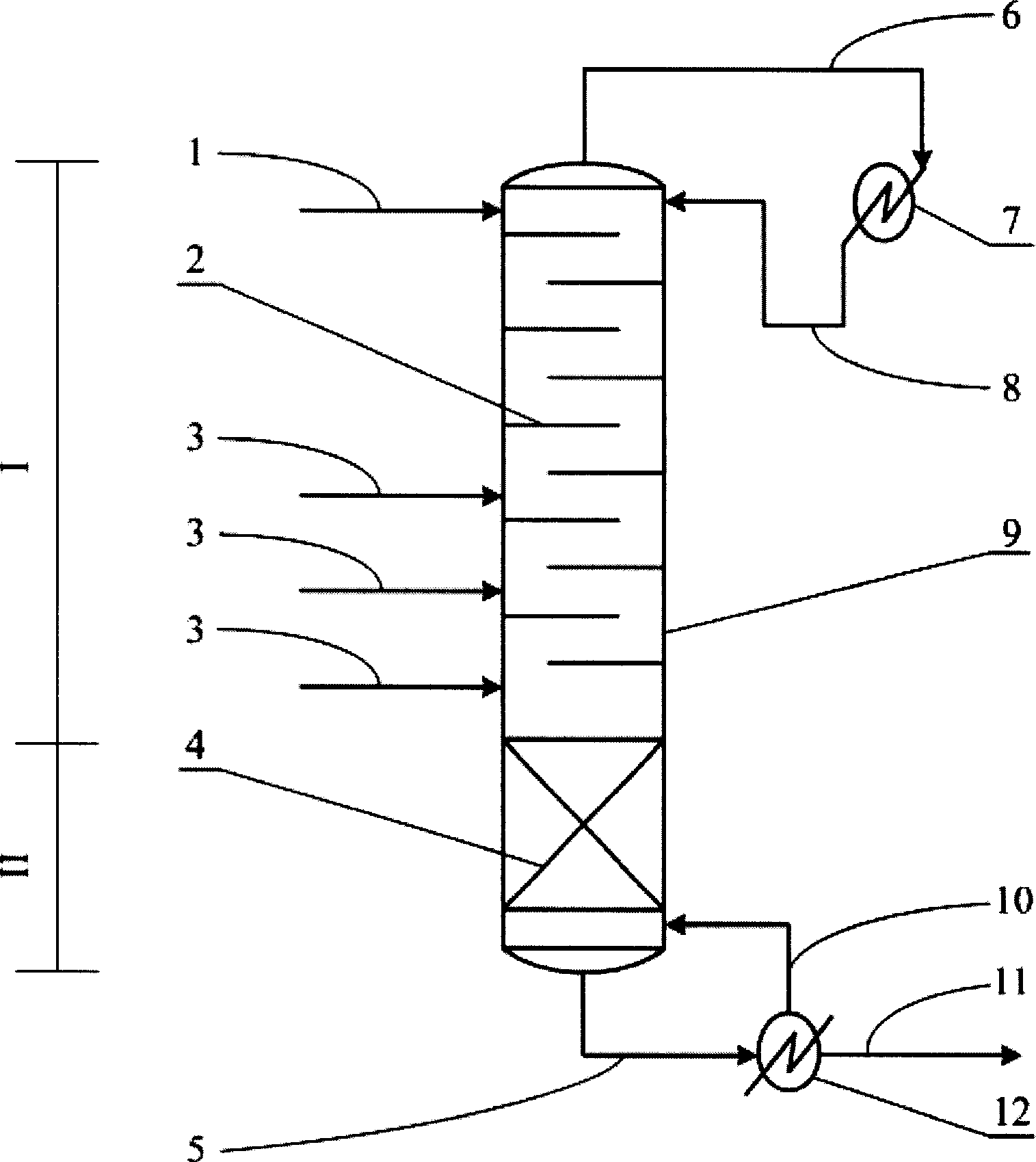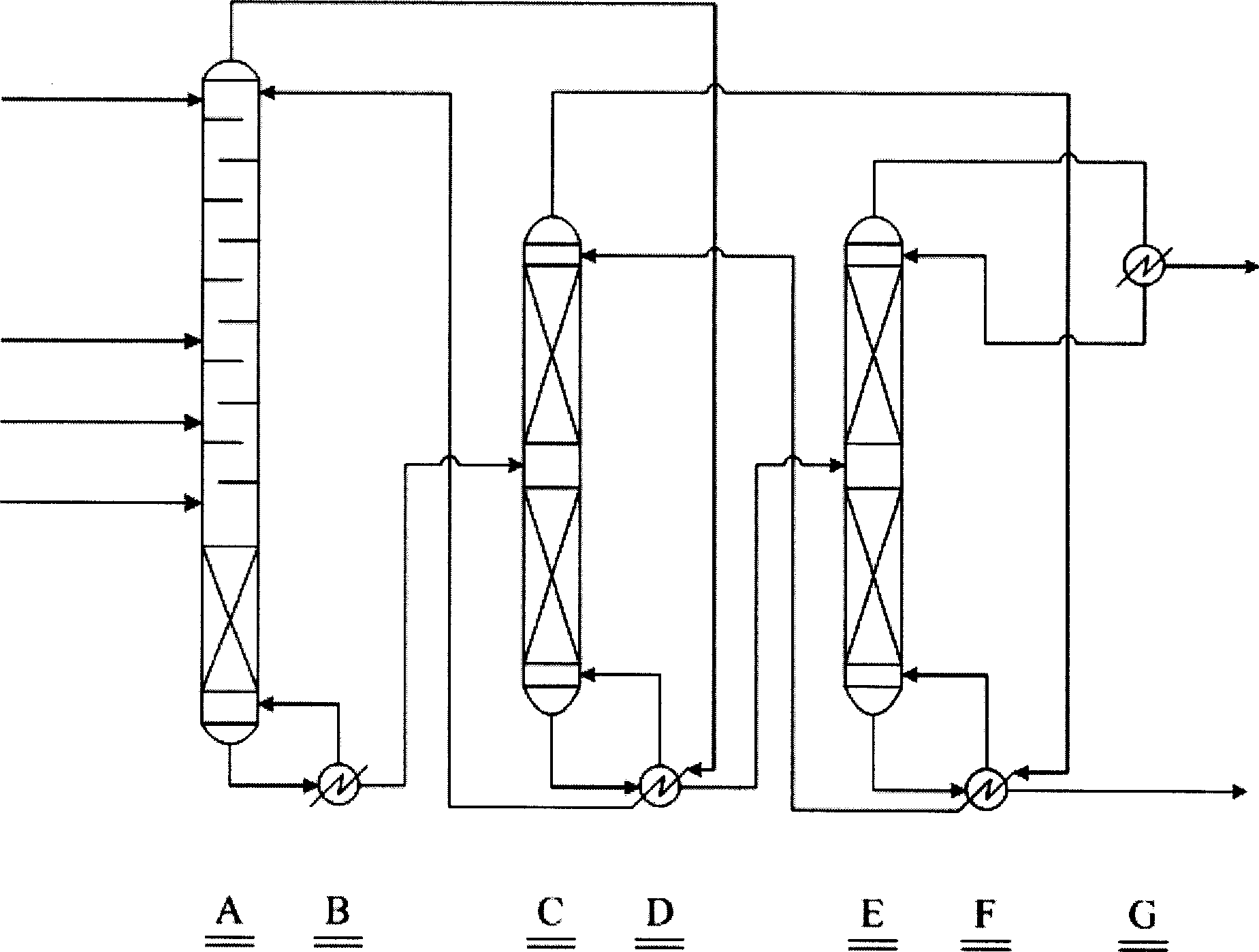Method for producing glycol by epoxy ethane hydration
A technology of ethylene oxide water and ethylene oxide, which is applied in the field of ethylene oxide hydration to ethylene glycol, can solve the problems of large equipment investment, long process flow, high water ratio of non-catalytic hydration reaction, and reduce production. cost, the effect of simplifying the process
- Summary
- Abstract
- Description
- Claims
- Application Information
AI Technical Summary
Problems solved by technology
Method used
Image
Examples
Embodiment 1
[0026] In the reactive distillation tower with an inner diameter of 24 mm, 10 trays in the reactive distillation section and 6 trays in the stripping section are set. Water is fed from the upper part of the tower at a flow rate of 21.6 g / h, while ethylene oxide has only one feed port, and feeds from the eleventh tray (counting from top to bottom) at a flow rate of 17.6 g / h. Feed the material in a molar ratio and the water ratio is 3:1. Ethylene oxide and water react in the reactive distillation section. The reaction temperature is 184°C. The operating pressure of the tower is 1.1MPa in absolute pressure. The product stream (including monoethylene glycol, diethylene glycol and a small amount) (Polyethylene glycol) through the liquid phase enters the next layer of trays, and enters the stripping section, where the product is concentrated by the stripping section, and the product is discharged from the bottom of the tower. The total mass of the feed is equal to the total mass of the ...
Embodiment 2
[0031] In the reactive distillation tower with an inner diameter of 24 mm, 15 trays in the reactive distillation section and 6 trays in the stripping section are set. Water is fed from the top of the tower at a flow rate of 18.0 g / h. There are three feed ports for ethylene oxide. The total flow rate is 17.6 g / h and divided into three streams of the same flow rate from the 9th, 12th, and 15th plates (from the top). From the next few), the feed was fed separately, and the feed was in a molar ratio, and the water ratio was 2.5:1. Ethylene oxide and water react in the reactive distillation section. The reaction temperature is 184°C. The operating pressure of the control tower is 1.1MPa in absolute pressure. The product stream (including monoethylene glycol, diethylene glycol and A small amount of polyglycol) enters the next layer of trays through the liquid phase and enters the stripping section, where the product is concentrated by the stripping section, and the product is discharged...
Embodiment 3
[0036] According to the kinetic data obtained in Examples 1 and 2, the internal diameter of the reactive distillation column is 4400 mm, the reactive distillation section has 20 trays, and the stripping section has 8 trays to simulate the production scale. Water is fed from the top of the tower at a flow rate of 390.3 kmol / h, and ethylene oxide has only one feed port, and it is fed from the twentieth tray (counting from top to bottom) at a flow rate of 139.4 kmol / h. The feed is measured in molar ratio, and the water ratio is 2.8:1. The operating pressure of the control tower is 1.2MPa in absolute pressure, the temperature of the tower bottom is 207.7°C, and the typical temperature of the reactive distillation section is 188°C. The discharge at the top of the tower is condensed into a single liquid phase with cooling water, and all flows back into the tower, and only the discharge at the bottom of the tower.
[0037] Water
Ethylene oxide (EO)
Ethylene glycol (MEG) ...
PUM
 Login to View More
Login to View More Abstract
Description
Claims
Application Information
 Login to View More
Login to View More - R&D
- Intellectual Property
- Life Sciences
- Materials
- Tech Scout
- Unparalleled Data Quality
- Higher Quality Content
- 60% Fewer Hallucinations
Browse by: Latest US Patents, China's latest patents, Technical Efficacy Thesaurus, Application Domain, Technology Topic, Popular Technical Reports.
© 2025 PatSnap. All rights reserved.Legal|Privacy policy|Modern Slavery Act Transparency Statement|Sitemap|About US| Contact US: help@patsnap.com


